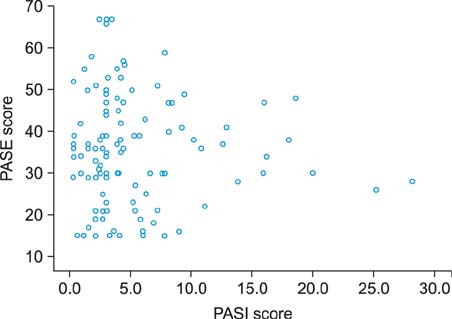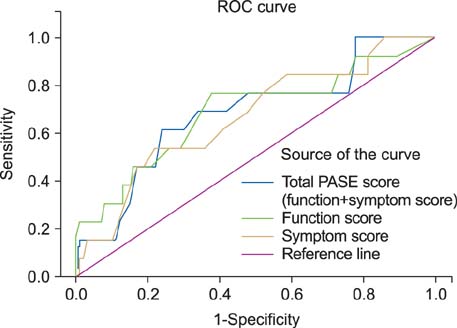Ann Dermatol.
2014 Aug;26(4):457-461. 10.5021/ad.2014.26.4.457.
Turkish PASE: Turkish Version of the Psoriatic Arthritis Screening and Evaluation Questionnaire
- Affiliations
-
- 1Postgraduate Student, Istanbul University, Istanbul, Turkey.
- 2Department of Dermatology and Venereology, Cerrahpasa Medical Faculty, Istanbul University, Istanbul, Turkey. burhanengin2000@yahoo.com
- 3Department of Internal Medicine, Division of Rheumatology, Cerrahpasa Medical Faculty, Istanbul University, Istanbul, Turkey.
- 4Department of Biostatistics, Cerrahpasa Medical Faculty, Istanbul University, Istanbul, Turkey.
- KMID: 2265585
- DOI: http://doi.org/10.5021/ad.2014.26.4.457
Abstract
- BACKGROUND
Psoriatic arthritis (PsA) is an inflammatory arthritis associated with psoriasis and causes irreversible joint damage, unless detected early and treated with systemic drugs.
OBJECTIVE
There is no reliable tool for screening PsA among Turkish psoriasis patients. Therefore, we aimed to validate the psoriatic arthritis screening and evaluation (PASE) questionnaire in the Turkish.
METHODS
A 15-item Turkish PASE questionnaire was administered to 122 consecutive psoriasis patients who visited our dermatology clinic for routine evaluations. Then, the patients were evaluated for PsA by a rheumatologist who was blinded to the results of the questionnaire.
RESULTS
Among the 113 patients who participated in the study, 11.5% (13 of 113) had a diagnosis of PsA. The Turkish PASE total scores ranged from 15 to 67 (possible range, 15~75). The median total score was 49 (25th and 75th percentile, 36 and 50) for the PsA group and 35 (25th and 75th percentile, 27 and 42) for the non-PsA group. The median total score of the PsA group was significantly higher than that of the non-PsA group (p=0.33). The Turkish PASE total score of 44 distinguished PsA from non-PsA participants, with 62% sensitivity and 76% specificity. For further analysis of each question, we counted the responses according to symptoms (positive for "agree" and "strongly agree" and negative for "disagree" and "strongly disagree"), and the sensitivity ranged from 23% (third question of the functions subscale) to 77% (second question of the symptoms subscale, first and fifth questions of the functions subscale) and the specificity ranged from 51% (second question of the symptoms subscale) to 87% (fourth question of the functions subscale). No relation was found between the PASI scores and the presence (p=0.899) or absence (p=0.941) of PsA, as well as between the PASI and PASE scores of each patient (p=0.961).
CONCLUSION
Thirteen of the 15 items demonstrated significant test-retest reliability as assessed with the Spearman correlation coefficient (p<0.05). These results show that the Turkish version of the PASE questionnaire may be useful for identifying PsA patients for inclusion in trials; however, it is not a reliable tool for screening PSA patients in a dermatology clinic.
MeSH Terms
Figure
Cited by 1 articles
-
Usefulness of the Psoriatic Arthritis Screening and Evaluation Questionnaire to Monitor Disease Activity in Management of Patients with Psoriasis: Findings from the EPI-PSODE Study
Yong Beom Choe, Chul Jong Park, Dae Young Yu, Youngdoe Kim, Hyun Jeong Ju, Sang Woong Youn, Joo-Heung Lee, Byung Soo Kim, Seong Jun Seo, Seok-Kweon Yun, Joonsoo Park, Nack In Kim, Jai Il Youn, Seok-Jong Lee, Min-Geol Lee, Kwang Joong Kim, Young Suck Ro, Hae Jun Song, Bong Seok Shin, Sung Ku Ahn, Ji Yeoun Lee, Young Ho Won, Min Soo Jang, Ki Ho Kim, Myung Hwa Kim, Tae Yoon Kim, Jee-Ho Choi
Ann Dermatol. 2019;31(1):29-36. doi: 10.5021/ad.2019.31.1.29.
Reference
-
1. Stern RS. The epidemiology of joint complaints in patients with psoriasis. J Rheumatol. 1985; 12:315–320.2. Feldman SR, Fleischer AB Jr, Cooper JZ. New topical treatments change the pattern of treatment of psoriasis: dermatologists remain the primary providers of this care. Int J Dermatol. 2000; 39:41–44.
Article3. Congi L, Roussou E. Clinical application of the CASPAR criteria for psoriatic arthritis compared to other existing criteria. Clin Exp Rheumatol. 2010; 28:304–310.4. Veale DJ, FitzGerald O. Psoriatic arthritis--pathogenesis and epidemiology. Clin Exp Rheumatol. 2002; 20:6 Suppl 28. S27–S33.5. Husni ME, Meyer KH, Cohen DS, Mody E, Qureshi AA. The PASE questionnaire: pilot-testing a psoriatic arthritis screening and evaluation tool. J Am Acad Dermatol. 2007; 57:581–587.
Article6. Dominguez PL, Husni ME, Holt EW, Tyler S, Qureshi AA. Validity, reliability, and sensitivity-to-change properties of the psoriatic arthritis screening and evaluation questionnaire. Arch Dermatol Res. 2009; 301:573–579.
Article7. Alenius GM, Stenberg B, Stenlund H, Lundblad M, Dahlqvist SR. Inflammatory joint manifestations are prevalent in psoriasis: prevalence study of joint and axial involvement in psoriatic patients, and evaluation of a psoriatic and arthritic questionnaire. J Rheumatol. 2002; 29:2577–2582.8. Gladman DD, Schentag CT, Tom BD, Chandran V, Brockbank J, Rosen C, et al. Development and initial validation of a screening questionnaire for psoriatic arthritis: the Toronto Psoriatic Arthritis Screen (ToPAS). Ann Rheum Dis. 2009; 68:497–501.
Article9. Moll JM, Wright V. Psoriatic arthritis. Semin Arthritis Rheum. 1973; 3:55–78.
Article
- Full Text Links
- Actions
-
Cited
- CITED
-
- Close
- Share
- Similar articles
-
- Screening for Psoriatic Arthritis in Korean Psoriasis Patients Using the Psoriatic Arthritis Screening Evaluation Questionnaire
- Investigation of the Correlation Between the Visually Induced Motion Sickness Susceptibility Questionnaire and the Turkish Motion Sickness Susceptibility Questionnaire
- Validation of the Dutch Eating Behaviour Questionnaire Children (DEBQ-C) version in Turkish preadolescence children
- Reliability and Validity of the Turkish Version of Children's Somatization Inventory
- Translation and validation of the Turkish version of the Psychosocial Impact of Dental Aesthetics Questionnaire



